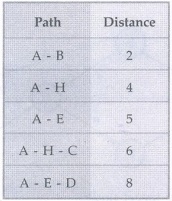Data Structure: Unit IV : Multiway Search Trees and Graphs
Finding Shortest Path
Operations, Algorithm with Example C Programs | Graphs | Data Structure
Dijkstra's Algorithm is a popular algorithm for finding shortest path.
Finding Shortest Path
•Dijkstra's
Algorithm is a popular algorithm for finding shortest path.
• This
algorithm is called single source shortest path algorithm because in this
algorithm, for a given vertex called source the shortest path to all other
vertices is obtained.
• This
algorithm applicable to graphs with non-negative weights only.
Ex. 5.14.1 Obtain the shortest path for the
given graph.

Sol. Now we will consider each
vertex as a source and will find the shortest distance from this vertex to
every other remaining vertex. Let us start with vertex A.

Thus the
shortest distance from A to E is obtained.
that is
A-B-C-E with path length = 4 +1+3 = 8 obtained by choosing appropriate source
and destination.
Ex. 5.14.2 Using Dijkstra's algorithm find the
shortest path from the source node A

Sol. The source node S={A}, the
target nodes
P =(B,
E, H, C, D}
Step 1: S = {A}
P = {B,
E, H, C, D}
d(A,
B)=2
d (A, H)
= 4
d. (A,
D) =∞
d(A,
E)=5
d (A, C)
= ∞
The
minimum distance is 2. Hence choose vertex B.
Step 2:
S {A, B}
d(A, E)
= 5
d(A,
H)=4
P = {E,
H, C, D}
d(A, C)
= 2 + 5 = 7
d (A,
D)=∞
The
minimum distance is 4. It is obtained from vertex H. Choose vertex H.
Step 3:
S={A, B,
H}
d (A,
E)=5.
P = {E,
C, D}
d (A, C)
= 4+2 = 6
d (A, D)
= ∞
Choose
vertex E
Step 4:
S ={A,
B, H, E}
P = {C,
D}
d(A, C)=6
choose
vertex C
d(A, D)
= 5+3=8
Step 5:
S={A, B,
H, E, C}
P = {D}
d (A, D)
= 8
choose
vertex D.
S={A, B,
H, E, C, D}
Thus the
shortest paths from single source S is as given below

Ex. 5.14.3 Implementation of Shortest Path
Algorithm (Application of Graph)
Sol. :
#include<stdio.h>
#include
<conio.h>
#define
infinity 999
int
path[10];
void
main()
{
int
tot_nodes,i,j,cost[10][10],dist[10],s[10];
void
create(int tot_nodes,int cost[][10]);
void
Dijkstra(int tot_nodes,int cost[][10], int i,int dist[10]);
void
display(int i,int j,int dist[10]);
clrscr();
printf("\n\t\t
Creation of graph ");
printf("\n
Enter total number of nodes ");
scanf("%d",
&tot_nodes);
create(tot_nodes,cost);
for(i=0;i<tot_nodes;i++)
{
printf("\n\t\t\t
Press any key to continue...");
printf("\n\t\t When Source =
%d\n",i);
for(j=0;j<tot_nodes;j++)
{
Dijkstra
(tot_nodes, cost,i,dist);
if(dist[j]==infinity)
printf("\n
There is no path to %d\n",j);
else
{
display(i,j,dist);
}
}
}
}
void
create(int tot_nodes,int cost[][10])
{
int
i,j,val,tot_edges,count=0;
for(i=0;i<tot_nodes;i++)
{
for(j=0;j<tot_nodes;j++)
{
if(i==j)
cost[i][j]=0;//diagonal
elements are 0
else
cost[i][j]=infinity;
}
}
printf("\n
Total number of edges");
scanf("%d",
&tot_edges);
while(count<tot_edges)
{
printf("\n
Enter Vi and Vj");
scanf("%d
%d", &i,&j);
printf("\n
Enter the cost along this edge");
scanf("%d",&val);
cost
[j][i]=val;
cost[i][j]=val;
count++;
}
}
void
Dijkstra (int tot_nodes,int cost [10][10], int source,int dist[])
{
int
i,j,v1,v2,min_dist;
int
s[10];
for(i=0;i<tot_nodes;i++)
{
dist[i]=cost
[source][i];//initially put the
s[i]=0;
//distance from source vertex to i
//i is
varied for each vertex
path[i]=source;//all
the sources are put in path
}
s[source]=1;
for(i=1;i<tot_nodes;i++)
{
min_dist=infinity;
v1=-1;//reset
previous value of v1
for(j=0;j<tot_nodes;j++)
{
if(s[j]==0)
{
if(dist[j]<min_dist)
{
min_dist=dist[j];//finding
minimum distance
v1=j;
}
}
}
s[v1]=1;
for(v2=0;v2<tot_nodes;v2++)
{
if(s[v2]==0)
{
if(dist[v1]+cost
[v1][v2] <dist[v2])
{
dist[v2]=dist[v1]+cost[v1][v2];
path[v2]=v1;
}
}
}
}
}
void
display(int source,int destination,int dist[])
{
int i;
getch();
printf("\n
Step by Step shortest path is...\n");
for(i=destination;i!=source;i=path[i])
{
printf("%d
<-",i);
}
printf("%d",i);
printf("
The length=%d",dist[destination]);
}
Output
Creation
of graph
Enter
total number of nodes 5
Total
number of edges 7
Enter Vi
and Vj 0 1
Enter
the cost along this edge 4
Enter Vi
and Vj 0 2
Enter
the cost along this edge 8
Enter Vi
and Vj 1 2
Enter
the cost along this edge 1
Enter Vi
and Vj 1 3
Enter
the cost along this edge 3
Enter Vi
and Vj 2 3
Enter
the cost along this edge 7
Enter Vi
and Vj 2 4
Enter
the cost along this edge 3
Enter Vi
and Vj 3 4
Enter
the cost along this edge 8
Press
any key to continue...
When
Source =0
Step by
Step shortest path is....
0 The
length=0
Step by
Step shortest path is...
1<-0
The length=4
Step by
Step shortest path is...
2<-1-0
The length=5
Step by
Step shortest path is...
3<-1-0 The length=7
Step by
Step shortest path is...
4<-2<-1-0
The length=8
Press
any key to continue...
When Source =1
Step by
Step shortest path is...
0<-1 The length=4
Step by
Step shortest path is...
1 The length=0
Step by
Step shortest path is...
2<-1 The length=1
Step by
Step shortest path is...
3<-1
The length=3
Step by
Step shortest path is...
4<-2<-1
The length=4
Press
any key to continue...
When
Source =2
Step by
Step shortest path is...
0<-1<-2
The length=5
Step by
Step shortest path is...
1<-2
The length=1
Step by
Step shortest path is...
2 The
length=0
Step by
Step shortest path is...
3<-1<-2
The length=4
Step by
Step shortest path is...
4<-2
The length=3
Press
any key to continue...
When Source =3
Step by
Step shortest path is...
0<-1<-3
The length=7
Step by
Step shortest path is...
1<-3 The length=3
Step by
Step shortest path is...
2<-1<-3
The length=4
Step by
Step shortest path is...
3 The
length=0
Step by
Step shortest path is...
4<-2<-1<-3
The length=7
Press
any key to continue...
When
Source =4
Step by
Step shortest path is...
0<-1<-2<-4 The length=8
Step by
Step shortest path is...
1<-2<-4 The length=4
Step by
Step shortest path is....
2<-4
The length=3
Step by
Step shortest path is...
3<-1<-2<-4
The length=7
Step by
Step shortest path is...
4 The
length=0

Ex. 5.14.4 Apply an appropriate algorithm to
find the shortest path from 'A' to every other node of A. For the given graph.

Sol. We will follow following
steps to obtain topologically sorted list.
Step 1: S = {A}, T= {B,C,D,E}
d(A,B) 3
← Min distance. select B
d(A,C) =
∞
d(A,D) =
∞
d(A,E) =
∞
Step 2: S = {A, B}, T = {C, D, E}
d(A,C)=d(A,B)+d(B,C)=3+6=9
d(A,D) =
d(A,B) + d(B,D) = 3+1 = 4←
select D
d(A,E) =
d(A,B) + d(B,E) = 3+5=8
Step 3: S ={A, B, D}, T = {C,E}
d(A,C) =
9
d(A,E) =
8 ← select this
Step 4: S ={A, B, D,E}, T = {C}
d(A,C) =
9
Step 5 Thus the shortest path from
'A' to every other node

Review Question
1. Explain the various applications
of graphs.
Data Structure: Unit IV : Multiway Search Trees and Graphs : Tag: : Operations, Algorithm with Example C Programs | Graphs | Data Structure - Finding Shortest Path
Related Topics
Related Subjects
Data Structure
CS3301 3rd Semester CSE Dept | 2021 Regulation | 3rd Semester CSE Dept 2021 Regulation
